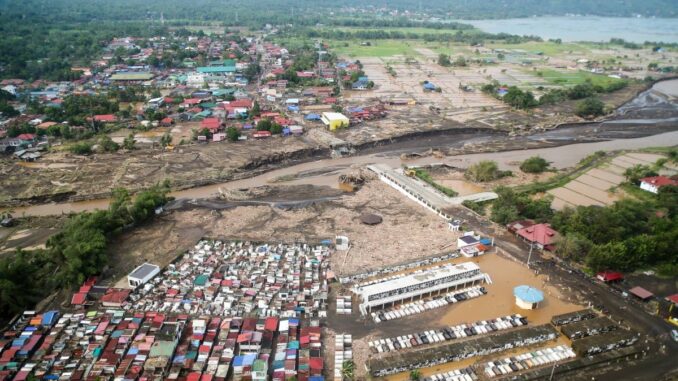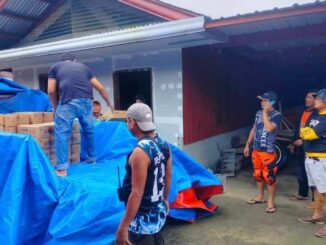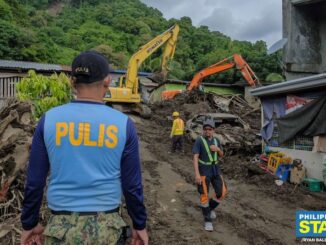
SOME 125 people have been reported dead due to Severe Tropical Storms Kristine and Leon, disaster officials said Tuesday.
The National Disaster Risk Reduction and Management Council (NDRRMC) said the death toll was still subject to verification, as only 14 cases have been verified so far.
Kristine and Leon affected a total of 7.13 million people or 1.79 million families from 10,181 villages nationwide.
The number of damaged houses rose to 78,286, 5,491 of which were destroyed.
The estimated damage to agriculture was placed at P2.8 billion and to infrastructure at P1.5 billion.
Storm Signal No. 2 was raised over Northern Luzon provinces as Leon developed into a typhoon, the state-run weather bureau said Tuesday.
Affected areas include Batanes, Babuyan Islands, the eastern portion of mainland Cagayan, and the northeastern portion of Isabela, the Philippine Atmospheric, Geophysical and Astronomical Services Administration (Pagasa) said in its 11 a.m. bulletin.
It raised Signal No. 1 over the rest of mainland Cagayan, the rest of Isabela, Quirino, Nueva Vizcaya, Apayao, Kalinga, Abra, Mountain Province, Ifugao, Benguet, Ilocos Norte, Ilocos Sur, La Union, Aurora, the northern portion of Quezon including Polillo Islands, Camarines Norte, the eastern portion of Camarines Sur, Catanduanes, the eastern portion of Albay, and the northeastern portion of Sorsogon.
The center of the eye of the typhoon was estimated at 565 kilometers northeast of Virac, Catanduanes, while moving west-northwestward at 10 kilometers per hour (kph).
It had maximum sustained winds of 130 kph near the center and gustiness of up to 160 kph, the weather agency said.
Leon will be closest to Batanes between early Thursday morning and noon, it said.
Pagasa administrator Nathaniel Servando said the typhoon might make landfall in Batanes and said there was an “increasing chance to reach the super typhoon category.”
Servando earlier told The Manila Times that although the center of the typhoon would not hit land, its core circulation may directly affect extreme Northern Luzon and the Batanes group of islands.
“Based on current track forecast, Leon will pass through Batanes before moving or making landfall over Taiwan,” he added.
Almost a week after tropical storm Kristine pummeled the country, 12 national roads were still impassable, the Department of Public Works and Highways (DPWH) said Tuesday.
DPWH Secretary Manuel Bonoan said of the 12 impassable national roads, one was in Region 2, two were in Region 3, three were in Region 4A, five were in Region 5, and one was in Region 7.
Three national bridges were also impassable.
Bonoan said the DPWH is actively monitoring and clearing roads to ensure the safety and accessibility of the national road network, which is crucial for relief efforts in the affected areas.
In other storm-related news:
– The National Electrification Administration (NEA) said it has been doubling its efforts in partnership with the various electric cooperatives to fully restore the electrical connections damaged by Severe Tropical Storm Kristine. Citing data, NEA administrator Antonio Mariano Almeda said a total of 2.1 million households from 12 regions in the country had no electricity for days following the onslaught of Kristine. But due to the massive restoration efforts of the agency and concerned electric cooperatives, only 500 households remain without electricity, Almeda told the Bagong Pilipinas Ngayon television interview.
– President Ferdinand Marcos Jr. ordered the Energy Regulatory Commission to study the imposition of a moratorium on electricity line disconnections and payment collections from October to December 2024 in areas under a state of calamity due to Severe Tropical Storm Kristine. The Presidential Communications Office said the initiative was part of the government’s continued efforts to aid victims.
– Senate Majority Leader Francis Tolentino urged Pagasa to provide more accurate and detailed weather forecasts, saying this is essential to help mitigate the severe impact of typhoons. “Pagasa should not only release warnings like signal numbers 3 or 4. They should also specify the expected amount of rainfall in concrete terms,” Tolentino said. “For example, they could say that the rainfall will be three times heavier than usual or provide other clear indicators. This would be more understandable and could save lives. What happened in Talisay, where residents were caught off-guard by the volume of rainfall, could have been avoided with clearer warnings.”





Be the first to comment